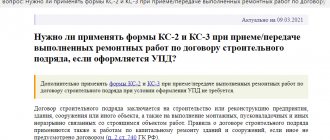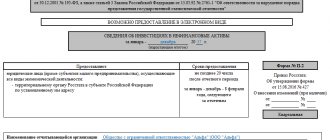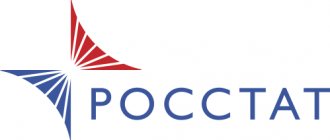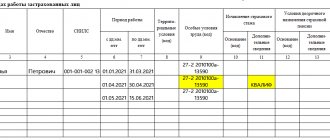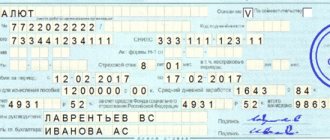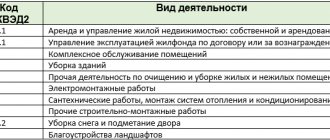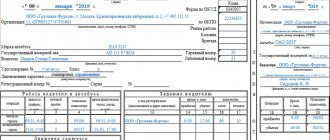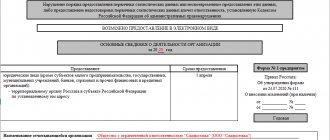Why do you need the KS-2 form?
The information from Rosstat indicates what the KS-2 and KS-3 forms are - this is the final documentation that is signed by the parties who entered into a state contract for construction, installation and repair work (Rosstat letter No. 01-02-9/381 dated 05/31/2005 ). The documents signed by both organizations mean that the parties have no claims to the volume and quality of the work performed and are the basis for further mutual settlements.
After the contractor fulfills its obligations under the government contract, the customer carries out inspection and acceptance. Confirmation of fulfillment of contract conditions is a signed act of acceptance of work performed - form KS-2. It is formed at the stage of closing the government order, after the supplier has fulfilled all obligations assigned to him, and the customer has checked the completeness and quality and accepted the work performed.
Completion of work acceptance certificate KS-2
The tabular part of the act is presented on two sheets, since the list of works usually includes many items. On the second page of the KS-2 form, at the end of the table, the line “Total for the act” has been added, where you need to add the “Total” from both pages. After this, the document must be signed by the contractor (“Passed”) and the customer (“Accepted”). This can be done by their representatives: on the contractor’s side, the person responsible for the work; on the customer’s side, the head of the company or his authorized representative.
The main thing when signing is to indicate the position, sign and indicate its decoding. In addition to signatures, the act must be certified by a seal on both sides. The only exceptions are individual entrepreneurs (IP), who are not required to use their printing activities. The correctness of the preparation of primary documentation is important, since if violations are detected and in the absence of documents in general, the head and accountant of the organization may receive administrative punishment.
Which form to use
To sign the final documentation upon completion of construction, repair or installation activities, the unified form KS-2 is used - OKUD 0322005. The forms of the act and certificate were developed and enshrined in the Decree of the State Statistics Committee No. 100 of November 11, 1999. The procedure for filling out and the content of the act depend on the type of work performed.
Although the form of the act is unified, the executor has the opportunity to modify it depending on his needs without violating current regulations.
ConsultantPlus experts sorted out what to use: a universal transfer act (UTD) or KS-2, KS-3. Use these instructions for free.
How to fill out
The act is formed after the completion of repairs, construction, or reconstruction of the facility. Here are step-by-step instructions on how to fill out KS-2 for a supplier:
Step 1. Fill out the introductory part - the header of the form. Information about the investor is filled in if there is such an economic entity in the contractual relations of the parties.
The basis for entering information about the customer and contractor is their registration information. Here the names of both organizations, their addresses, contact numbers and OKPO of each party are indicated.
Step 2. Fill in the “Construction” column - the address of the construction site under a government contract. In the “Object” field, indicate the full name of the subject of the contract.
In the fields we indicate the type of activity of the organization according to OKDP, the details of the contract - the number of the government contract and its date.
Step 3. We generate information about the period of work and indicate the details of the act. It is assigned a number in order and its date is indicated. The “Reporting period” sign shows the start and end dates.
Step 4. We enter the cost of construction, repair or installation work in accordance with the estimate. The amount must match the price specified in the contract and be written in rubles.
Step 5. Fill out the table. The table of this act is a reflection of the estimate for performing work under a government contract. The form accumulates data from several estimates.
All numbers in order (column 1), positions in the estimate (item 2) and names of work performed (item 3) are written down similarly to the lines of the estimate calculation. Numbers from the collections of federal unit rates (FER) are indicated in column 4 for each type of work, if available for this category. Column 5 reflects the unit of measurement - exactly as it is written in the estimate. It is not allowed to record the volume of work performed in percentage and proportional terms. Column 7 - “Price per unit in rubles.” — is formed using data from FER collections. If the terms of the contract require a fixed cost for contractual activities, then dashes are indicated in column 7.
Column 8 reflects the actual cost of construction or repairs based on the estimate, which is an integral annex to the government contract. This column is also filled in based on the calculated values for each item from the collections of federal unit prices.
Step 6. When the customer verifies the data from the act with the estimate and actual volumes, the act is signed by the manager or other responsible person.
The document is drawn up in two copies. The seal is affixed only if it is used by institutions. The report form also reflects all the comments that the customer makes to the contractor regarding inadequate quality, volume or deadlines.
Filling out the table in the KS-2 acceptance certificate
The next sheet of the act contains a table where it is necessary to list all the work performed. There is a line in front of the table in which you need to enter the estimated (contractual) cost, which must correspond to that specified in the contract. The amount can be presented in numbers; there is no need to decipher it in words.
The table in the act consists of 8 columns, which indicate the following information about the work:
- serial number (1);
- position number in the estimate (2);
- name (3);
- unit price number (4);
- in what units is it measured (m2, m3, tons, pcs., etc.), (5);
- quantity(6);
- unit price (7);
- total cost (8).
The tabular part reflects the data given in the estimate for construction work. Moreover, the table can accumulate values from several estimates.
Features of filling out the tabular part
To get the total cost of work (8), you need to multiply the values in columns (6) and (7), i.e., multiply the number of works by the unit price. The number in column (6) must in no case be stated as a fraction or percentage of the total to be completed. The price in column (7) is set in accordance with the collections of federal unit prices (FER). If the contract prices are fixed, then a dash is placed in column (7). In this case, column (8) is also indicated based on indicators taken from the FER collections.
It is important to write the title of the work in column (3) as clearly as possible, without abbreviations or combining two types into one. In case of such a violation, the customer has the right not to sign the document and request that the KS-2 again. After filling out all the lines, it remains to calculate how much was spent on all the work. This amount is recorded at the intersection of the column “Cost, rub.” and the “Total” lines.
It is important that in the KS-2 estimate the cost is indicated without VAT. If necessary, the amount including VAT can be added, but usually it is already given in the KS-3 certificate. Here is the amount without VAT (taxable base) and with VAT at the rate regulated by law, i.e. 20%.
Question indicating the cost of work and deduction of VAT
The final cost of the work in the KS-2 certificate and their cost in the KS-3 certificate must match. But in some cases, their divergence is allowed. This is possible in accordance with the Letter of Rosstat of the Russian Federation dated May 31, 2005 No. 01-02-9/381. It says that the cost of work in KS-2 is indicated in accordance with what is provided for in the estimate, and in KS-3 it will be the estimated cost, taking into account price changes, if this is provided for in the contract.
We mentioned this in our article about the KS-3 certificate. There are often cases when construction lasts more than one year, which is why the cost of work and building materials has changed. Therefore, the discrepancy in cost between KS-2 and KS-3 is not a violation.
It is equally important to take into account that if the contract does not provide for phased acceptance of construction work, but interim acts KS-2 are drawn up, the customer may face a refusal to accept VAT for deduction. Intermediate KS-2 are usually used for reporting specifically to the customer. To eliminate problems with VAT deduction, it is worth stipulating in the contract for the phased delivery of work.
Why do you need the KS-3 form?
Legislative regulations explain in what cases KS-2 and KS-3 are filled out - when purchasing construction and repair work. The result of the completion of the contract is acceptance by the customer organization and signature of the act. For final acceptance, the contractor draws up a certificate of the cost of the work.
A certificate of the cost of work performed and expenses is a financial document on the basis of which the cost of contracting activities is approved. In accordance with this documentation, the results of the execution of the government contract are reflected in the accounting records.
The form reflects information about the total cost and expenses for the object of repair, construction or installation activities. The certificate also indicates costs not taken into account in the estimate (price increases, rental costs, etc.).
Order a work acceptance certificate for KS-2
The Stroydok-ABV company offers services for the preparation of the necessary construction documentation, including primary reporting documents, which include the KS-2 work acceptance certificate. Its correct completion is important, since in the future the data is necessary for the preparation of another mandatory document - the KS-3 certificate. We can competently prepare these and other documents you need, which will allow you to quickly resolve all issues regarding the completed construction.
How to fill out
The basic rules for registering KS-2 and KS-3 are given in Goskomstat Resolution No. 100. The register is filled out in two copies: one for each party to the contract. If the contractual terms provide for the presence of an investor, then the form is drawn up in triplicate. The document is prepared both for the entire construction project and for each stage of construction or repair, indicating the full cost of contracting activities according to the estimate.
Algorithm for generating information in a certificate of cost of work:
- We enter information about the contractor and customer, their contacts, OKPO codes. The name of the construction site and details of the government contract are indicated here.
- We assign a number to the document in order and indicate the date of its formation, designating the reporting period.
- Let's fill out the table. Units of measurement, volumes and FER codes are not needed here. The table indicates only the names of contract actions, their numbers in order and prices on an accrual basis for the periods: from the beginning of the work, from the beginning of the year and data for a specific reporting period. If the performer has a need, actions are grouped by type of work code or type of equipment used.
- Let's summarize. We sum up the cost for each type of action, enter the result in the “Total” line and calculate VAT. We add up the estimated amount and the VAT amount and get the final price of the work.
- We sign the register and approve it with the customer organization. The certificate is certified by managers or other responsible persons. The seal is affixed if it is available in organizations.
If everything is filled out correctly, you will get a document like this:
Filling out KS-2: step-by-step instructions and sample
In the construction business, the use of form KS-2 is necessary and requires careful completion. The form contains the names of the work performed at the site, units of measurement, price per unit (excluding VAT), volume (quantity), total cost (the amount including VAT will be reflected in the “Total” line) and the reporting period. The act is printed for each interested party.
Sample of filling out the KS-2 form
- Filling out the form begins with the title section, which contains information about the investor, customer (general contractor) and contractor. Required fields: full names of organizations (parties); legal status; contacts, addresses.
- Next, information is entered into the “Construction” and “Object” sections, where the location of construction and installation work and the name of the object are indicated.
- Step three - recording the registration number of the act, the date the document was drawn up, the reporting period in which the work was carried out (usually a month is taken, since KS-2 is filled out on the basis of a log of completed work, which is kept monthly).
- This is followed by a listing of the work performed in the reporting period, filling in the cost in rubles according to the estimate in numbers, without decoding in words.
- The first two columns are numbers: serial and by estimate;
- the third column requires a description of the type of work performed;
- in the fourth - prices;
- in the next two columns fill in the units of measurement (meters, kilograms, pieces) and the total number of works;
- the seventh column indicates the price in rubles per unit of measurement;
- in the eighth – cost for each indicator;
- in the “Total” line indicate the total cost.
Together with the KS-2 form, a certificate on the KS-3 form about the cost of the work is filled out. This primary documentation is considered as a single whole; an act without a certificate has no legal force. Documents must be stored for five years.
Look at our step-by-step instructions on how to fill out the KS-2 form in the BIT.CONSTRUCTION program.
Explanations on the topic
| Main points | Document details | Download |
| On filling out the unified form No. KS-2 when concluding a government contract within the framework of Federal Law No. 94-FZ of July 21, 2005 | Letter of the Ministry of Economic Development No. D22-1743 dated September 27, 2010. | |
| In the letter, the Federal State Statistics Service explains the procedure for using unified forms of primary accounting documentation and filling out unified forms of primary accounting documentation in conventional monetary units | Letter of the Federal State Statistics Service dated May 31, 2005 No. 01-02-9/381. |
About the author of this article
Alexandra ZadorozhnevaAccountant, project expert Practicing accountant. I have been working since the beginning of my studies at the university. I have experience in both commerce and budgeting. From 2006 to 2012 she worked as an accountant-cashier and personnel officer. From 2012 to the present - chief accountant in a budgetary institution. In addition to direct accounting, I am involved in purchasing and economic planning activities. I have been writing feature articles for specialized publications for 4 years.
Other publications by the author
- 2022.02.28 Procurement control The Ministry of Finance clarified whether to simultaneously provide benefits to organizations of people with disabilities and penal institutions
- 2022.02.28 Procurement controlInstructions for drawing up a report on purchases from SMP and SONO according to 44-FZ
- 2022.02.25 Procurement control How the Treasury authorizes transactions with funds of treasury support participants from 2022
- 2022.02.25 Customer documents Plan to change the rules for drawing up FCD plans in institutions
